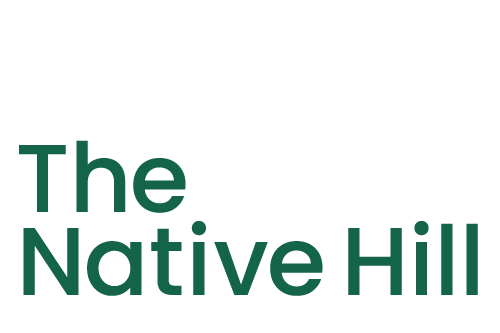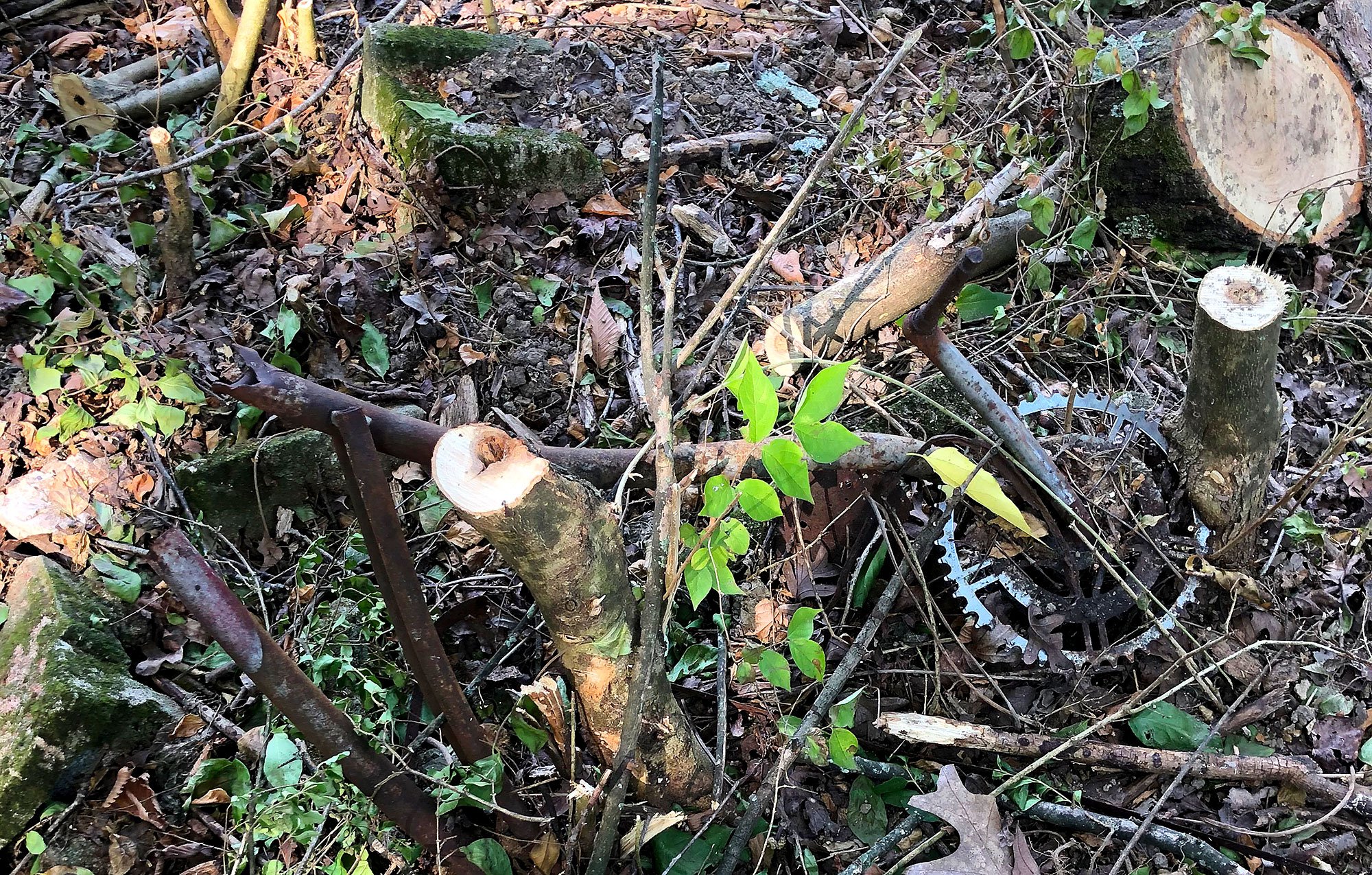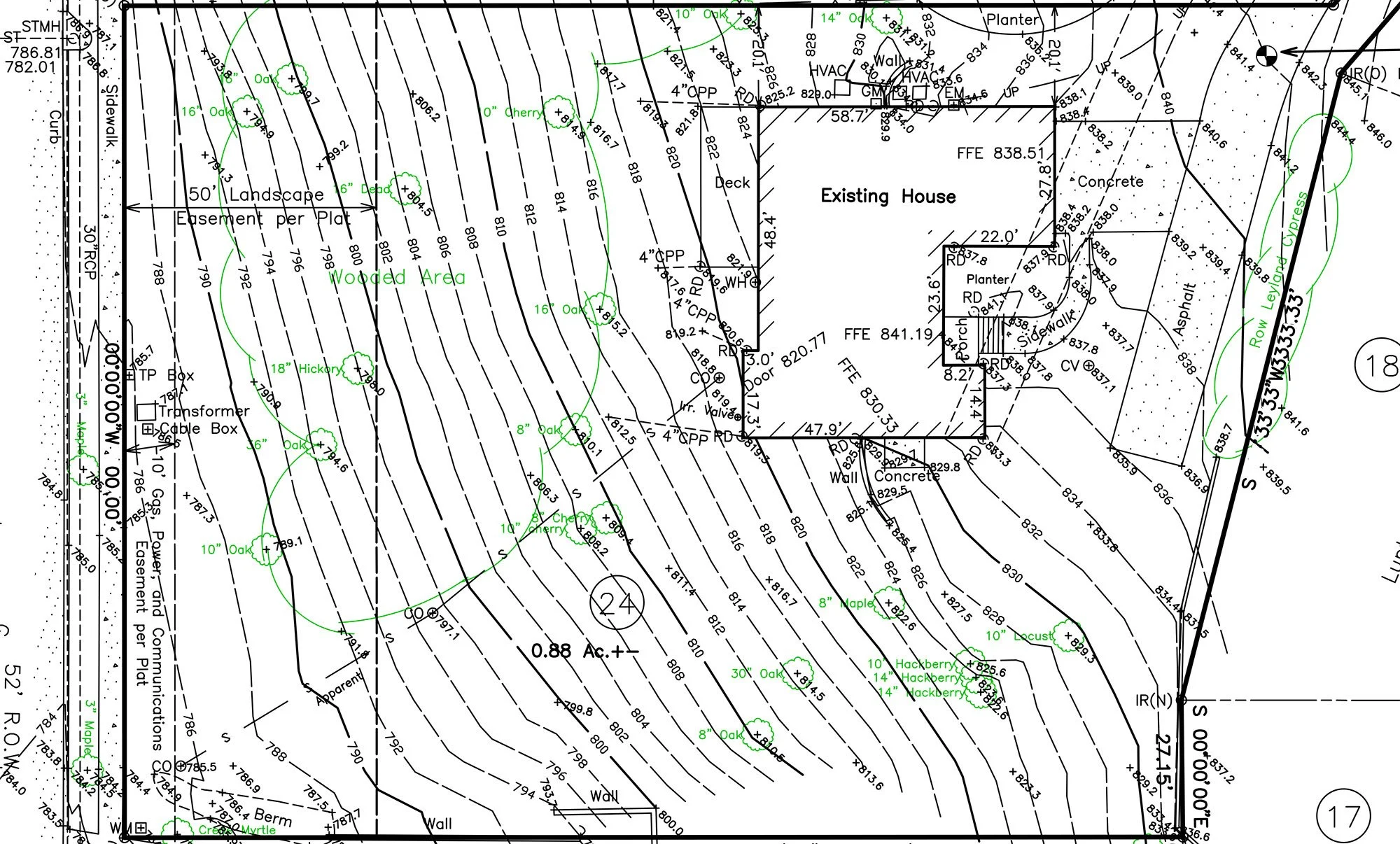In the Beginning
In 2016, we decided to leave our idyll, wooded property (with its crumbling 120-year-old cabin) on Lookout Mountain, Georgia, and move to the nearby city of Chattanooga, closer to our thriving software business downtown. Through a series of providential events, we found a home on an acre at the top of a hill in the northern part of town, with a lovely view of the Tennessee River and Lookout Mountain. When we first found our place, it seemed like a romantic dream, with a newish house (central heat and air!) on a one-acre partially wooded hillside lot, just 10 minutes from our downtown office.
In the beginning, God created everything, and God called everything “good.” Except for people. God called people “very good.” But after we purchased the property and had time to fully explore our hill, “good” would not be how we described our tiny slice of Creation. We don’t know who used to own this land, either before or after it was “developed,” but after surveying the damage, “very good” would not have been the first words from our mouths to describe them. We know that’s not fair. We don’t know anything about the prior owners. And who are we to judge?
After God created, humans decided they could run things better than the Creator. As a result, many people treat our world carelessly for lots of reasons, many of which seem good at the time. When we eventually see the impact of our decisions, just like Adam and Eve, we tend to try to hide or look for someone else to blame. But it doesn’t help.
While frustrated and overwhelmed with our situation, Donna and I realized that we just needed to face our present reality and make a reasonable plan to move forward.
A couple of obstacles: Removing invasive species and removing trash left by prior landowners.
Facing the Reality
About a third of our acre contained our house, a concrete driveway, an adjoining asphalt driveway, and a small, steeply sloping (and eroding) lawn that was nearly impossible to maintain. Though the house has a side door into a walk-out basement, we rarely used it as the steep slope made it virtually inaccessible without falling down the hill.
On the remaining part of the property, woods covered about half. Kudzu had overrun the native oak, maple, and walnut trees. Invasive Chinese privet, bush honeysuckle, and mimosa crowded the tender dogwood and redbud trees in the understory, making it impossible for these and other native species to thrive. The other half had been cleared and excavated to run utilities to the house from the street below. The excavation had stripped the understory plants, damaging delicate root systems that had previously held the hill in place. When we purchased the property, this part of our hill had evidently been neglected since the excavation, left to run amuck for nearly a decade. One-by-one, the remaining trees began to die, some of which had stood for hundreds of years. Erosion ate away the excavated part of the hill, causing terrible runoff that raised alarm with us and our nearby neighbors.
When faced with the plainly evident impact of prior human decisions (or indecisions), our romantic country-living-in-the-city dreams quickly faded. We started to feel like our hill had become all Mordor, and no Shire.
Our original property survey, indicating elevation changes and large tree locations.
Making the Plan
As followers of Jesus, we take our mandate to heal the brokenness of our world seriously. Though it would have been impossible to restore our property to its original condition, we decided it could be redeemed—eliminating the significant “debts” of its past—and somehow made into a better version that could meet our needs, the needs of our community, and the needs of local plant and animal species.
I (Ken) am a maker who loves designing, planning, and building. Donna is a cultivator and nurturer who also happens to be a Master Gardener with a keen interest in native plants. Even so, we could not handle a project of this magnitude as we both had more-than-full-time jobs in our software startup. Looking for help, we eventually contracted with a local landscape company to work with us on how to repair the damage and begin the process of healing our land.
We started with some guiding principles:
Remove invasive species that threaten the environment and replace them with native species to attract pollinating insects and in turn, native birds.
Plant fruit and vegetable gardens to supply our household and our friends and family with fresh food.
Avoid harmful herbicides and pesticides whenever possible and instead rely on birds, insects, and natural fertilizers and repellants.
Make the hill more accessible to humans, with pathways that provide a means to enjoy and continue to cultivate the land with less strain and stress on our aging bones.
The Zones
Our hill is tucked between an older neighborhood at the top, with smaller homes built for former factory workers, and a newer neighborhood of larger homes at the bottom, built primarily for executives and retirees. This means our front yard and driveway border the backyards of the older homes, while our backyard faces the newer homes at the bottom of the hill, where a sidewalk is used heavily by neighbors for walks or traveling to and from a community pool and park. The unique position of our lot offered a unique opportunity to connect us with both the old and new communities. We also shared the private driveway with our nearest next-door neighbor. So in literally every direction, we had to consider how our plan would impact others. With our landscape contractor, we mapped out four primary zones.
The woods. We wanted to make as few changes as possible here, protecting the older growth trees while clearing out dangerous dead trees and invasive species so we could reintroduce native species.
The main entries. This included our driveway, front porch, and a navigable entry to our basement. We also wanted to include a reasonably level patch of lawn where our grandchildren could play without fear of falling down the hill.
The switchbacks. The previously excavated part of the hill needed serious attention from top to bottom. After some initial clearing, we discovered that at some point in the past, a prior owner had attempted to terrace the top of the hill, but it had subsequently been used by others as a garbage dump. The rest of the hill needed serious work to redirect and slow down runoff from heavy rains that continue to worsen each year. Because most of the trees in this area had been removed or killed due to the work of the developer, this area now provided ample sun for potential fruit, vegetable, and flower gardens.
The bottomland. While not a true wetland environment, the focus of the bottom of the hill would be to slow and soak up as much rain water as possible before it could run off into the street or others’ properties. This meant adding lots of new trees and a bank garden that would show well to the rest of the neighborhood. Due to HOA restrictions and our desire to be good neighbors, we also wanted to leave some grassy areas where people could walk their pets. Previously derelict and scary looking, we also desired for this area to be transformed into another entry to our property—with enough of a screening effect to indicate private property but enough of a welcome mat to encourage use by visitors when we held parties. We hoped that our neighbors would be tempted to pause, gaze, and enjoy some beauty instead of scurrying past.
After a lot of back and forth discussions, we settled on a plan and a budget with our landscape contractor, submitted our plans to our HOA for approval, and finally the work on creating The Native Hill began in earnest.
What’s Next
In our next posts, we’ll discuss each zone in greater detail and provide what we hope will be helpful tips and lessons learned to those who desire to know. In some cases, we’re very happy with the results. In other cases, well, we still have a lot of experimentation and hard work ahead of us.
At the risk of scaring someone away, consider this as tip number one: When working with nature, the enduring effects of humanity’s ongoing decisions to usurp the Creator (the Fall) ensure that some things will fail. No matter how well we plan or how much money we spend, nature has a way of teaching us humility. But that’s not such a bad outcome, is it?




